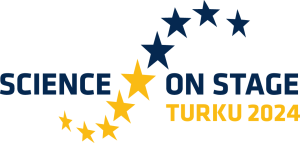Projects to promote STEM in elementary school for kids, 10 years or younger.
(Y1) “Little cardiologists”: Embodied learning activities for teaching about the circulatory system, G. Michael (CY)

Institution: Lympia Primary School
Subjects: Biology, science
This lesson was designed to enhance students’ understanding on how the circulatory system works and the role of models in science. Fifth graders were involved in embodied learning activities, which promote knowledge construction through the involvement of the body. Thus, all students are actively engaged in an inclusive class while having more fun and increased interest in relation to traditional activities. Students worked in groups and were involved in activities such as programing a robot, studying two- and three-dimensional models of the heart, playing with puzzles and electronic games and moving according to specific scenarios having the role of blood.
(Y2) Children discover algebra – Theme box “Equations and Functions”, D. Wellhausen & S. Schlinske (DE)

Institution: Annedore-Leber-Grundschule / iMINT-Akademie Berlin
Subjects: Mathematics, science
The inclusive learning arrangements of this theme box promote the development of algebraic thinking through exploratory learning at the primary school level. The children actively explore equations, variables, terms and patterns. The learning arrangements offer children with different learning requirements motivating, action-oriented and challenging tasks and thus promote the joy of mathematics.
They support the development of basic ideas about terms, equations and functions, which lays a foundation for successful mathematics learning in secondary school.
(Y4) Do British Dung Beetles affect plant growth? V. Walsh (UK)
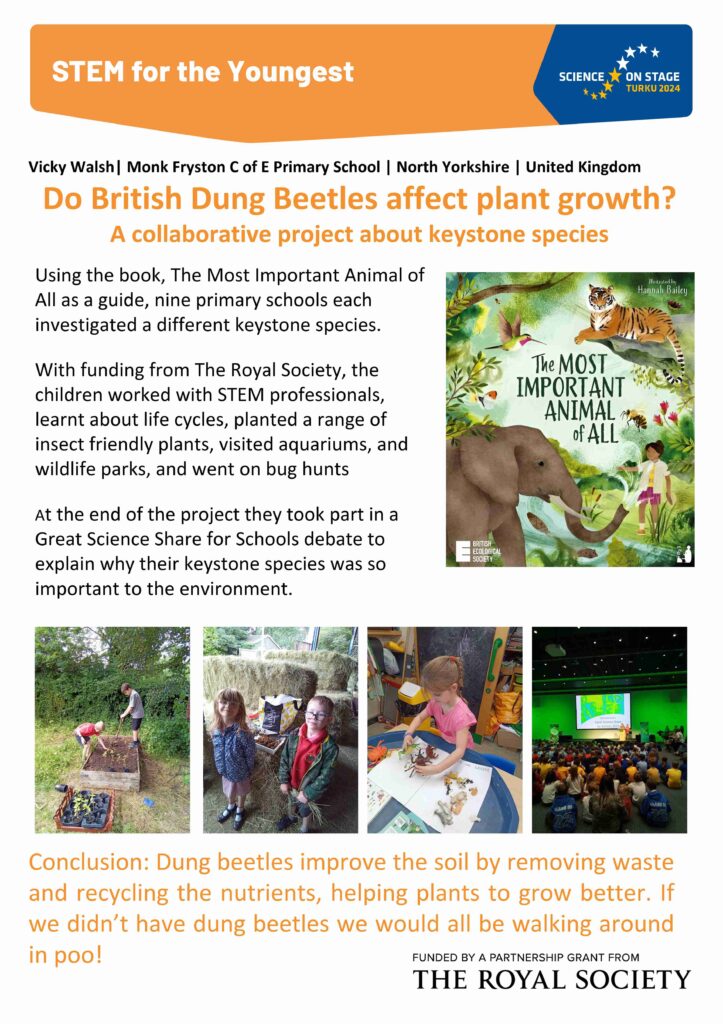
Institution: Monk Fryston C of E Primary School
Subjects: Science, geography, art, literacy
In 2021 our cluster of 9 primary schools began working with the author Penny Worms, after being inspired by her book “The Most Important Animal of All”. Each school took a keystone species to investigate, using the format of the book as a guide. Monk Fryston Primary school chose to investigate dung beetles. This rarely seen, and understudied animal in primary education, is incredibly important to our whole environment. The children were delighted to find out that without the hard work of this little creature, we would be knee deep in poo!
(Y5) Eco-housing Yurt, S. Sadykova (KZ)

Institution: Public School No7 of Altay city
Subjects: Mathematics, science, social studies, art
This easy-to-access project allows students to explore various aspects of the design of a yurt (the national portable dwelling of nomads), determine the materials most suitable for its production, and study stability and wind resistance. Students gain real-world experience by initiating and exploring their own questions.
On a global scale, it will allow cultural diversity to manifest itself, which contributes to sustainable development.
It promotes education for sustainable development: the opportunity to explore yurt design, including strength and wind resistance, allows students to gain knowledge about how to create an ecological lifestyle.
(Y6) EcoKids Teach AI, C. Meirinhos (PT)

Institution: EB de Vila Boa – Agrupamento de Escolas Gonçalo Nunes
Subjects: Computer science/ICT/IT
The Ecokids are on a heroic mission to rescue our precious planet! Their first bold step? Embarking on a thrilling journey of discovery to master the art of sorting rubbish for recycling and become recycling champions! With unwavering determination, they will conquer the challenge of sorting waste like true eco-warriors. But that’s not all! The Ecokids are poised to do something truly extraordinary – they will share their newfound knowledge with cutting-edge Artificial Intelligence (AI) technology, forging an unbreakable alliance to safeguard the future of our beloved humanity. Get ready for an epic adventure in eco-superheroism!
(Y7) Empowering Students: MATSKU Pedagogy´s Key Elements for Mathematical Success, N. Ågren (FI)

Institution: Kiiminkijoen koulu
Subjects: Mathematics
MATSKU pedagogy is a way of teaching mathematics flexibly and concretely, tailored to the individual skills of the student. The MATSKU books are published by the Finnish National Board of Education, and the pedagogy has been awarded in Finland.
Key elements of the MATSKU pedagogy include:
1) Concretization of the base ten system
2) Viewing numbers as combinations
3) Utilization of learning tools (such as blocks, sticks, egg cells, and base ten system tools)
4) Mathematical connections
5) Functionality and collaboration
The practice fosters learner confidence and encourages math discussion. It particularly supports the teaching of LUMA subjects to 5–10-year-olds as the target group.
(Y8) Fostering a Sustainable Commitment, E. Bäck & S. Torstensson (SE)

Institution: Sisjöskolan
Subjects: Science
The project spans 4 years when the puils are 6 – 9 years old, and involves work on various ecosystem components, such as butterflies, birds, bees, and fish. Examples include constructing nest boxes, breeding butterflies, and engaging in fish conservation together with the local fishing club (Sportfiskarna). Our approach centers on fostering sustainable commitment to nature through firsthand experiences, reinforcing classroom knowledge. The aim is to demonstrate the significance of individual actions and their positive impact on nature. We envision cultivating responsible citizens capable of making well-balanced decisions for sustainable development.
(Y9) Hoist the Sails! A. Fuller (CA)

Institution: Centre de services scolaires des Laurentides
Subjects: Mathematics, science, language, social studies
This project takes place in three phases and can be adapted to the curriculum no matter the grade. Throughout the first phase, the students are asked to discover the Vikings’ history by making a research about an artefact, reading some articles and reading children’s documentary books to know more about who the Vikings were. Then, throughout the second phase, the students manipulate the naval engineering criteria such as floating conditions and discover the Vikings and Canada First Nations method to build their water transportation device. Finally, the students are asked to use their knowledge developed in the previous phases to build a Viking boat.
(Y10) How does your garden grow? With green practices and sustainability! V. Ward (IE)

Institution: Dublin 7 Educate Together
Subjects: Biology, botany, environmental science, sustainability
Emphasising basic botany and environmental benefits, the pupils engaged in sustainable gardening, striving to create a greener urban landscape within the local community. The project prioritised conservation and advocacy for sustainability, integrating lessons on plant life, carbon sequestration, and biodiversity. From organic farming to green living, pupils applied knowledge in designing and constructing urban community garden planters, while also assessing local sustainability impacts. Through hands-on activities, group projects, and presentations, this interdisciplinary endeavour seamlessly wove together various subjects, uniting the broader community to address the real-world challenge.
(Y11) Design of a housing for a Roman snail, M. Reiser, M. Nosek & M. Hennig (DE)
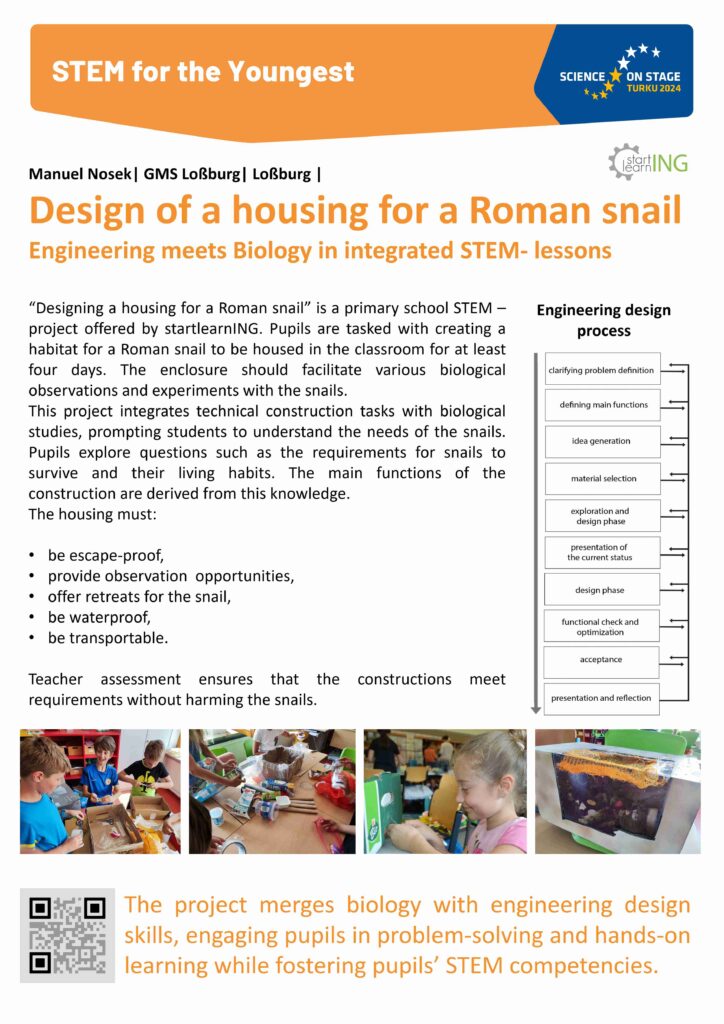
Institution: GMS Loßburg & Hochschule Reutlingen & Pädagogische Hochschule Weingarten
Subjects: Biology, technology, social competencies
The students build a dwelling for a snail in which the animal is held and observed species-appropriate for one to two weeks in the classroom. At the beginning it’s about the biological aspects of the snail and systematic problem solving when designing.
Without building instructions, but using a checklist with the requirements the dwelling has to fulfill, the children use recycled material to build the dwelling based on working methods used by engineers.
Differentiated information texts and a lot of practical work enable the implementation independently of cognitive ability and first language.
(Y12) Light up House – The secrets of an Electrical Switch, I. Fonseca & Â. Costa (PT)

Institution: Agrupamento de Escolas a Sudoeste de Odivelas & Agrupamento de Escolas de Carnaxide
Subjects: Portuguese, environmental studies, English
“The activity “Light Up House – The secrets of an Electrical Switch” uses an everyday context to encourage students to investigate materials as good or bad electrical conductors.
The experiment’s focal point is a light switch. Students are challenged to design a switch using suitable materials (conductors and/or insulators) to control a silicone LED strip that provides light to a small acrylic model house. To do this, the students need to create a simple electrical circuit to place on the back of the model house. The components of the electrical circuit and how they connect to each other are taught through a board game called: “Lit or Unlit House?”
(Y13) Grab a Bucket- We are Taking Learning Outdoors, N. Bolton (UK)

Institution: Tattenhall Park Primary School
Subjects: Science
Bucket School is a versatile, portable learning model that can be used as a vehicle to deliver science (and subjects across the curriculum), outdoors. At a fraction of the cost of building an outdoor classroom, it generates a scaffold for creative and inspirational learning, while providing a powerful way to promote a love of learning outdoors. At a time when our current generation of children are becoming increasingly disconnected from the natural world, Bucket School is the perfect tool to promote outdoor inquiry-based learning in a simple way. All you need to create a Bucket School is a class set of buckets and your imagination!
(Y14) Green Drama in Early Childhood Education, Z. Gubis (FI)

Institution: City of Helsinki Kindergarten (ECEC) Veräjämäki
Subjects: Green Drama in Early Childhood Education
Green drama is an environmental education method implemented through drama. It aims to promote sustainable development and change in human activities. It improves everyday skills, interaction and expression, phenomenon-based learning and art etc. At the core of drama is always a story/fairy tale, involving nature/environment and sustainable development. Children get to take the story forward by experimenting and participating, and come up with solutions by playing, exploring and inventing, regardless of their age. Getting to know STEAM subjects takes place naturally in the theatrical milieu of the session. Green Drama strengthens both children’s circular economy skills and future literacy.
(Y15) Lunar craters: debate and investigation, B. Avella (IT)

Institution: Scuola Primaria Antonio Nuzzo – Istituto Comprensivo Via Casal Bianco
Subjects: Mathematics, science, English, citizienship education
The activity is about moon craters. The project aims to promote active learning and develop citizenship skills, with the teacher acting as a facilitator of learning. Students were involved through videos and reading aloud from a book in English (to enhance female scientists). They participated in a debate on theories about the origin of lunar craters, searching for and using informational texts and digital sources. They conducted an investigation of factors influencing the size and shape of lunar craters using IBSE.
Students were provided with guides and materials and shared their results. They evaluated themselves and their peers using rubrics and graphic organisers.
(Y16) The amazing uses of paper, B. Mahy (BE)

Institution: École des Éoliennes
Subjects: Science
Paper, what a formidable object! We use it every day without wondering about its properties and uses other than simply printing our lessons. This everyday life tool could be the answer to the question many of us ask ourselves: How can I do science with few means? Let’s discover the paper universe together through eight simple experiments! On the menu: dissolution, capillarity, colours, light and scientific challenges.
(Y17) Ogulin – the city of fairy tales and STEM, B. Stipetić (HR)
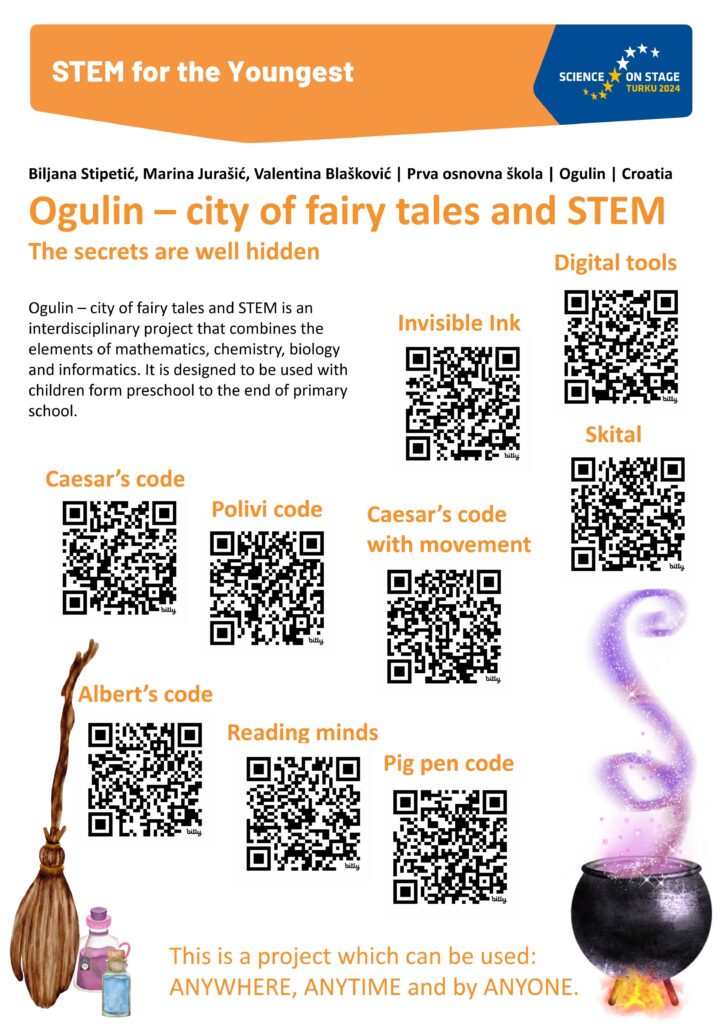
Institution: Prva osnovna škola
Subjects: Chemistry, mathematics, computer science/ICT/IT
‘Ogulin – the city of fairy tales and STEM’ is an interdisciplinary project adapted to the age of students from 6 to 12 years old, which does not require large funds for implementation and can be implemented in every classroom. As part of the project, students are engaged in mathematics in such a way that they explore the basics of cryptography. The students are also introduced to a number guessing technique. In addition, students are introduced to the invisible alphabet and the world of chemistry. Through the project, students will get to know digital tools that will make it easier to encrypt and decrypt texts and additionally master skills in the field of informatics.
(Y18) How long is a second – timestudies, K. Rehunen & S. Kolhonen (FI)
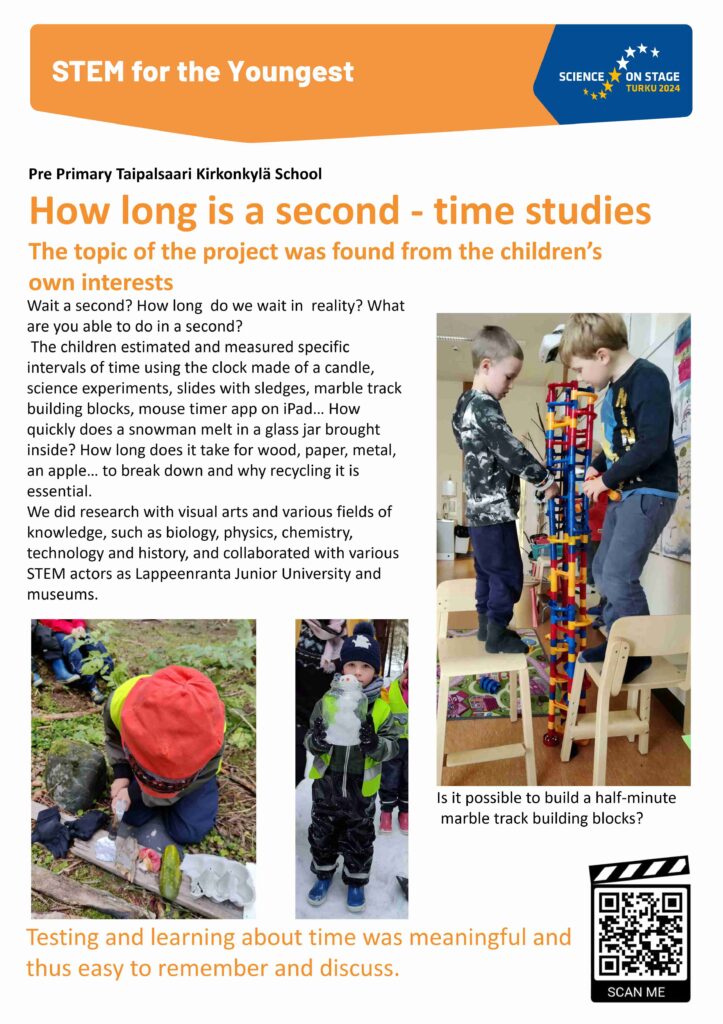
Institution: Taipalsaari Kirkonkylä school
Subjects: Physics, chemistry, mathematics, technology, science, arts and crafts, physical education
The goal of the project was to investigate time, time-related concepts, and the manifestation of time in various situations in children’s everyday lives. “How long does it take for a ball to fall? How quickly can toys be cleaned up? How fast can we run from one end of the hall to the other? How long does the longest slide on the slide take? How quickly does a snowman melt in a glass jar brought inside?”
We realized the core principles of project work while studying time, and children worked together to build knowledge through various experimental and functional tasks. The phenomenon of time required a lot of innovative approaches and concreteness.
(Y19) Send Andreas Mogensen into Space, M. Hejn (DK)

Institution: Lille Værløse Skole
Subjects: Engineering, science
The students will design and build model sized rockets out of paper and send them into space, together with Andreas Mogensen, a Danish astronaut, using the launch pad.
In the design process they will build, test and optimize their rockets. To achieve maximum height and/or length, they must rebuild and retest the rocket repeatedly.
The students’ work is based on an engineering model where they collect data throughout the process and use it in the rebuilding process. For measuring the height, the students will film the launch in slow-motion. The length is measured manually.
When the project is completed, the students will show the best rocket and share their considerations in a presentation.
(Y20) STEAM X – Reinventing STEAM for little ones, A. Zhumakhan (KZ)
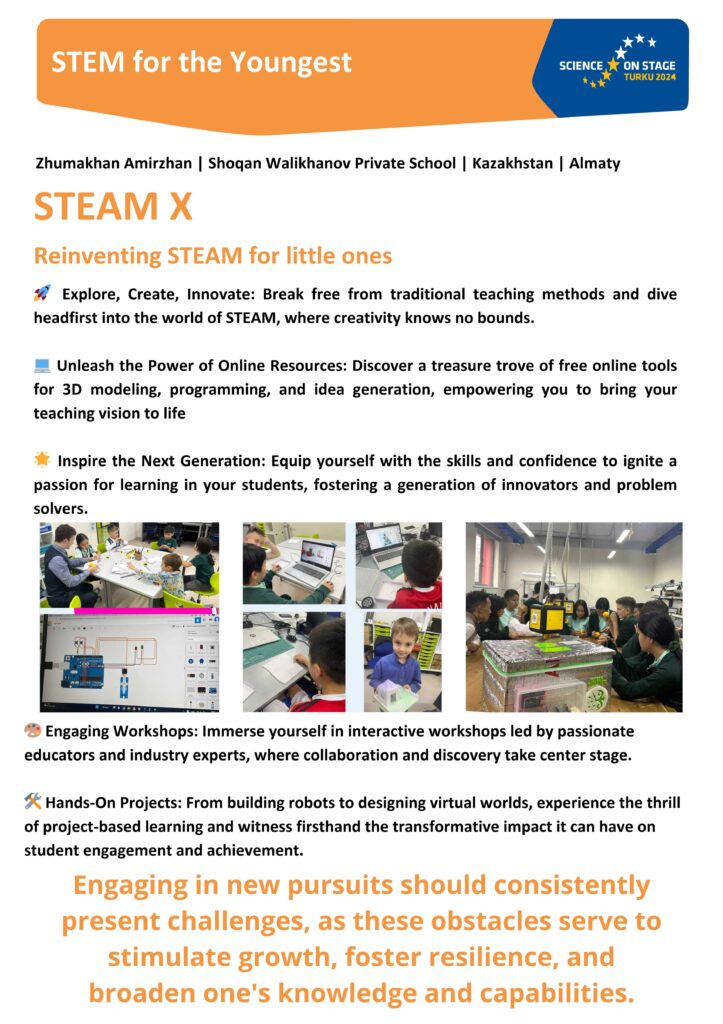
Institution: Shoqan Ualikhanov Private School
Subjects: STEM, STEAM
STEAM X is an author education methodology. The ‘X’ embodies the boundless journey of understanding complex concepts through intuitive exploration. By presenting intricate subjects with simple analogies, STEAM X is a way to rethink traditional teaching. For instance, Ampere is an imaginary character, that illustrates electrical current. Understanding the concept of current helps to enhance knowledge to basics of programming. Programming is a key to creating easy projects. And any project itself is a way to start connecting theoretical STEAM fields with practice. The idea of project is to suggest teachers a way to keep children interested and stimulated for studying, knowing that is are much more than theory in field of STEAM.
(Y21) The Magic Lab, S. Todorova & T. Nencheva (BG)

Institution: Radost Kinergarden
Subjects: Physics, biology, chemistry
Within the project, we use scientific experiments that are easy, accessible, and interesting for children in kindergarden. We conduct experiments with milk, water, light, using everyday products and objects to demonstrate the effect of static electricity, we involve children in the world of ecology and environmental protection by building a small purification station with materials at hand. In an easy, fun, and interesting way, children empirically prove the presence of impurities, determine the qualitative composition of milk and milk products. We educate them about the properties of water and its interaction with substances, we show how reflected light affects our perception.
(Y22) Science for Kids, A. Fusi & M. Pavan (IT)

Institution: Liceo Scientifico Galileo Ferraris
Subjects: Physics
Our project introduces early elementary school children to the scientific method. What’s innovative is that our students are guiding the children in this endeavour. The students collaborate with us under the supervision of the university to design simple experiments aimed at capturing the children’s attention, astonishing them, and sparking their curiosity and questions. The laboratory is divided into the four elements: earth, air, water, and fire. For each of these, experiments are devised to investigate specific properties or introduce more general concepts. We invite you to visit the station for more details. The work done becomes a part of their curriculum.
(Y23) Making wildflower seed bombs using recycled materials, M. Kelly (UK)

Institution: St Catherine’s Prep School
Subjects: Mathematics, technology, science, design, English
Every year, each KS2 year group has the task to create an eco-friendly enterprise project with limited resources. The project brief was to make an eco-friendly product to sell at a profit and the profits from the sale to be donated to an eco charity of their choice. The year 4 pupils decided to create wildflower seed bombs.
(Y24) STEAM Education in the Early Childhood Education, A. Hätönen (FI)

Institution: Little Heroes International Kindergarten
In our project we are creating a model to bring science education into early childhood education. In our kindergarten the school year is divided into five different periods with their own topics. We divided science education into five areas according to the periods: natural sciences, chemistry, mathematics, technology and physics. We awaken children’s interest in different areas of science through plays and experiments. We give time for wondering and for the children’s own observations.
In our ECE unit, the ages of children are 1 – 6 years. We enable children’s inclusion and participation in science education. It is important for every child to have an experience to be a part of the group.
(Y25) The Great River, A. Mika & A. Czeczko (PL)

Institution: High School No. 14 with Bilingual Departments & Janusz Kusociński Primary School Nr 5
Subjects: Biology, anatomy
The project is dedicated to primary school children and it depicts the story of how the human circulatory system works. The teacher’s verbal narration, based on The Sixth Great Montessori Lessons, is illustrated with a demonstration and a simple experimentation performed by the children and the teachers. The project is an introduction to human anatomy, an analysis of the human body as an organism composed of systems, organs, tissues and cells. During the activities, children learn about the circulatory system, they create a blood composition model and perform experiments related to the functioning of the circulatory system, the work of the heart and blood vessels.
(Y26) The Magic Apple, J. Babić & L. Sokolović (RS)

Institution: Primary school Milić Rakić Mirko & Primary school Nikodije Stojanović Tatko
Subjects: Mathematics, technology, engineering, science, art, Serbian language, civil education, music
The magic apple is a project that deals with the problem of how the apple, as a type of plant, behaves in experiments that simulate natural processes, what physical changes occur as a result of chemical reactions and whether there are cause-and-effect relationships that can be observed. The experiments that were carried out during the project encourage students to observe the laws that exist in the rest of the living world. The goal of the project is to introduce students to the impact of apples on health, the benefits of apples, types of apples, how to consume apples and apple products, as well as how to market products on the market.
(Y27) Vitamin Green Boxes, L. Kovalenko & O. Artemieva (UA)

Institution: specialized ecology-economical school n° 67
Subjects: Biology, mathematics, computer science/ICT/IT
A healthy lifestyle is becoming increasingly popular among young people and one of the goals of any primary school teacher is to teach them how to do it. One of the components of a healthy lifestyle is nutrition but it is difficult to imagine a healthy diet without vegetables and greens. Together with my pupils we plant microgreens, which have become a real trend of healthy food in the world’s cuisine. Nutritionists call them superfood because microgreens, despite their minimal calories, are a source of a large number of vitamins. Research on the cultivation of microgreens expands knowledge and opens up new perspectives for children to use microgreens as an environmentally efficient source of food.
(Y28) SE – IF : Artificial Intelligence vs Natural Intelligence, C. Fornelli (IT)
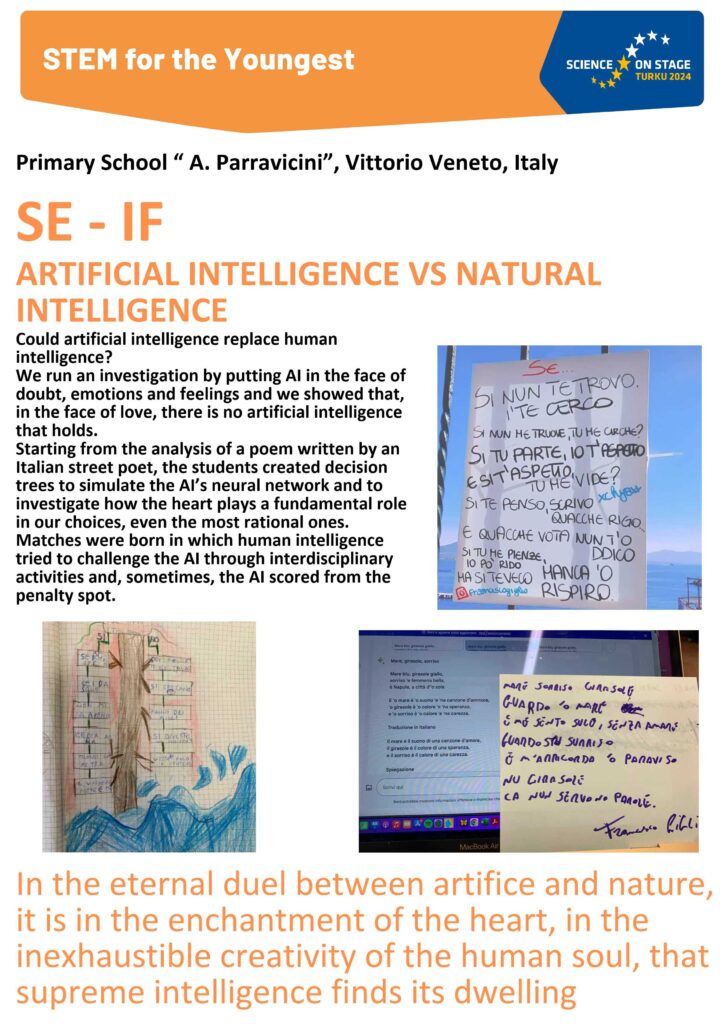
Institution: Primary School Allessandro Parravicini
Subjects: Technology, science, English, Italian literature, art
Could artificial intelligence replace human intelligence?
We run an investigation by putting AI in the face of doubt, emotions and feelings and we showed that, in the face of love, there is no artificial intelligence that holds.
Starting from the analysis of a poem written by an Italian street poet, the students created decision trees to simulate the AI’s neural network and to investigate how the heart plays a fundamental role in our choices, even the most rational ones.
Matches were born in which human intelligence tried to challenge the AI through interdisciplinary activities and, sometimes, the AI scored from the penalty spot.
(Y29) The Power of Science – Physical and Chemical Regularities, D. Georgieva (BG)

Institution: Primary school “St. Paisii Hilendarski”
Subjects: Physics, chemistry, humans and nature
The aim of the project is creating interest in science, provoking the attention of the smallest children to the physical and chemical phenomena in everyday life that they can observe. The experiments that young students are introduced to spark curiosity about science and prompt them to look for new ideas to show how it works.The power of science is the power which provokes interest in knowledge. My professional practice with already grown students shows, that this interest in scientific experiments leaves lasting knowledge in them and supports the learning of physics, chemistry and biology in the upper grades.
(Y30) The Magic of Winter STEM, I. Nahorniuk (UA)

Institution: Zhytomyr Lyceum 21
Subjects: Mathematics, technology, science, art
In our project we encourage primary school students to engage in hands-on activities to show alternatives to the problematic constant use of mobil phones. The students design and make Christmas decorations and toys. Creating unusual toys from salt dough, paper, wool and wood attracts young learners and provokes them to spend their time creatively. We are ready to share our teaching experience in making 2D paper snowflakes and 3D paper icicles, designing artificial snow and snowmen. Children apply their basic knowledge and skills from mathematics, technology, art, and science through hands-on activities and improve observational, experimental and inquiry-based skills. The project is eco-friendly with reasonable expenses.
(Y31) What is in the Black Box? J. Spirts & N. Stocka (LV)

Institution: Jelgava’s 5th secondary school
Subjects: Physics, mathematics, engineering, science, electronics
The work offers opportunities to implement the technique in primary school exact science subjects. (mathematics, engineering, natural sciences, etc.).
Intriguing students with its mysteriousness, the principle of black box tasks is as follows: we have some unknown system and we try to understand its internal structure by performing different actions and receiving the information provided by the black box.
Actions with the box can be repeated or changed to refine the known information and learn what is hidden under the hood.
Black box tasks develop thinking; they include all the steps of research activity developing analytical, problem-solving and critical thinking skills.
(Y32) The Universe, P. L. Santamaría (ES)

Institution: Obra Diocesana Santo Domingo de Silos
Subjects: Astronomy
This work began with an investigation about the universe, focusing on the solar system and the bodies in it to create two presentations on the universe. We also made a model related to this topic.
The first presentation was shown to the pupils of primary at Santo Domingo de Silos School with an explanation of the model and accompanied by a simulation experiment about the craters on the moon and another experiment of creating a galaxy in a glass with which it was explained how a galaxy could look, what colors could form it and which contributed to making the explanation more entertaining and didactic at the same time.
More complex presentation was taught to the ESO students.
(Y33) Let´s play math outdoors, A. Hakkarainen (FI)
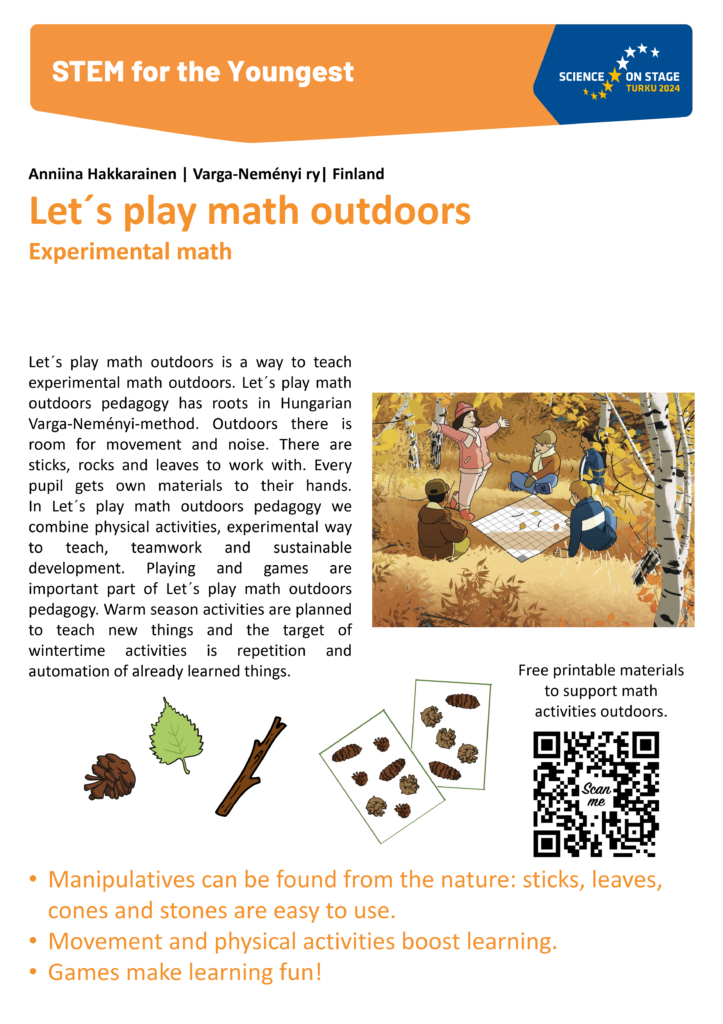
Institution: Varga-Neményi ry
Subjects: Mathematics, physical education
Let´s play math outdoors is a way to teach experimental math outdoors. Let´s play math outdoors pedagogy has roots in the Hungarian Varga-Neményi-method. Outdoors, there is room for movement and noise, there are sticks, rocks and leaves to work with. Every pupil gets their own materials to work with. In Let´s play math outdoors pedagogy, we combine physical activities, an experimental way to teach, teamwork, and sustainable development. Playing and games are are important part of Let´s play math outdoors pedagogy. Warm season activities are planned to teach new things and the target of wintertime activities is repetition and automatization of already learned things.
(Y34) The secrets of the constellations, N. Ivanova (BG)
Institution: Izzi Science for Kids
Subjects: Physics, astronomy
The project is about the constellations on the celestial sphere and has been successful in primary and lower secondary grades. Starting by inventing constellations on a real but unlabeled star map, the kids go through several activities to learn that constellations cover some surface of the sky rather than just form a recognisable shape. This includes activities such as a puzzle where each constellation from the Northern hemisphere is a separate piece and others. The concluding activity is making a 3D constellation model that shows the distances from the stars to us to illustrate that stars in a constellation have very different distances from us and aren’t usually physically connected.
